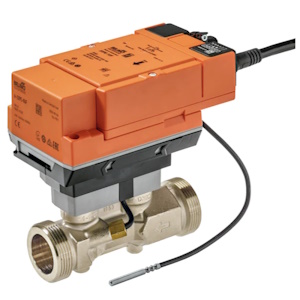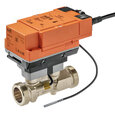HVAC Energy Efficiency

Figure 1: HVAC energy meter to measure energy efficiency in a heating or cooling circuit
Improving the energy efficiency of industrial HVAC systems is crucial for reducing energy costs, minimizing environmental impact, and improving system longevity and performance. HVAC systems consume high energy in buildings, often around 40% of the total energy. There's a lot of potential to save energy and money by making HVAC systems more efficient. This article discusses the various reasons for excessive energy consumption in an HVAC system and various strategies to optimize it.
Table of contents
- Advantages of an efficient HVAC system
- Excessive HVAC energy consumption
- HVAC energy optimization strategies
- FAQs
View our online selection energy meters!
Advantages of an efficient HVAC system
- Enhancing HVAC system energy efficiency has several advantages:
- Lower operational expenses
- Decreased carbon emissions, aiding in achieving net-zero goals
- Minimized equipment downtime, leading to greater production continuity
- Prolonged lifespan of equipment due to reduced strain
- Improved environmental conditions, including ventilation, temperature regulation, and compliance
- Greater comfort and satisfaction for occupants, resulting in fewer complaints
Excessive HVAC energy consumption
HVAC systems often consume more energy than necessary due to various reasons.
- Inefficient equipment and maintenance: Older, inefficient HVAC units, along with a lack of regular maintenance, can lead to increased energy consumption due to reduced operational efficiency and airflow impediments.
- Improper sizing and insulation: Oversized and undersized HVAC systems and poor building insulation contribute to unnecessary energy use by causing the system to cycle more frequently and work harder to maintain desired temperatures.
- Air leakage and ductwork issues: Unsealed gaps in the building envelope and leaky or uninsulated ducts result in significant energy loss, as conditioned air escapes and unconditioned air infiltrates the space.
- Control systems and design: The absence of advanced control systems or improper configuration can lead to excessive HVAC operation, while systems not tailored to the building's specific needs can prevent optimal efficiency.
- Internal loads and extreme weather: High internal heat loads from occupants and equipment, coupled with extreme outdoor temperatures, increase the demand for HVAC systems, leading to greater energy usage.
- Design focused on peak load conditions: Engineering tools often concentrate on the highest demand times, missing the details of how systems work during normal, less intense conditions where they actually run less efficiently and are used most often.
HVAC energy optimization strategies
No-cost strategies for lowering HVAC energy expenses include setting optimal temperatures to avoid unnecessary cooling or heating. Also, limit air conditioning to necessary spaces and close dampers/grills in unused areas. The main strategies to enhance HVAC efficiency are discussed below.
Real-time monitoring systems
Real-time monitoring systems equipped with HVAC energy meters are vital for optimizing energy efficiency in HVAC systems. These meters measure the specific energy usage of HVAC components, allowing for precise monitoring and analysis of energy consumption patterns.
Integrating energy meters into these systems provides immediate feedback on system performance, using IoT technology to detect inefficiencies or malfunctions. This enables quickly addressing issues, adjusting settings, and maintaining optimal operation, preventing energy waste and reducing costs.
Key control loops to monitor
Monitoring control loops is crucial for HVAC energy efficiency. For example, AHUs, chillers, and boilers all utilize advanced sensors and control systems to regulate air, chilled water, and boiler water temperatures to meet a building's specific heating or cooling demands. These systems feature reset capabilities that automatically adjust temperature setpoints based on factors such as external weather conditions, internal load changes, or occupancy levels, thereby optimizing comfort and maximizing energy efficiency across different climate control technologies. Other monitoring options and maintenance requirements are discussed below.
Air handling units (AHUs)
- Economy mode (free cooling): Economy mode, also known as free cooling, is a feature in AHUs that takes advantage of cooler outside air to reduce the need for mechanical cooling when the outdoor temperature is lower than the indoor temperature, thereby saving energy.
- Variable air volume (VAV) controls: VAV controls adjust the volume of air delivered to different zones or rooms in a building based on demand, which can be determined by factors such as occupancy, temperature, or air quality, leading to enhanced comfort and reduced energy consumption. Supplying only the necessary air for conditioning or ventilation is more efficient than constant air volume.
- Airspeed: Delivering air at low velocity is more efficient than high-velocity air through small ducts.
AHU maintenance steps for energy efficiency include:
- Clean water coils
- Check for air leaks in panels and water leaks in coils and pipes
- Secure damper linkages and ensure no leakage in dampers
- Calibrate key control sensors (temperature, humidity, differential pressure, etc.)
Chillers
- Primary and secondary pump control: In systems with primary and secondary chilled water loops, pump controls manage the flow of water. The primary pump circulates water through the chiller, while the secondary pump distributes it throughout the building. Control strategies can vary flow rates to match cooling demands and optimize energy use.
- Condenser water temperature reset: This control strategy adjusts the temperature of the water returning to the chiller's condenser based on ambient conditions or cooling load. The chiller can operate more efficiently by optimizing the condenser water temperature, particularly during part-load conditions.
- Chiller staging parameters: Chiller staging involves turning on or off multiple chillers in sequence or modulating their capacity to match the cooling load. Parameters are set to determine the conditions under which each chiller will be activated or deactivated, ensuring that the chillers operate efficiently and effectively to meet the building's cooling requirements.
Chiller maintenance steps for efficient performance include:
- Calibrate control sensors (temperature, differential pressures)
- Keep strainers clean
- Maintain chiller tubes and filters
- Check oil levels
Boilers
- Pump controls: Pump controls in boiler systems regulate the flow of hot water or steam throughout the building, ensuring that the right amount of heat is delivered where needed. These controls can adjust pump speed and operation to match the system's heating demand, improving energy efficiency and occupant comfort.
- Boiler staging parameters: Boiler staging involves the sequential operation of multiple boilers to match the heating load, with parameters set to determine when each boiler should fire up or shut down. This strategy optimizes the use of boilers, ensuring they run at peak efficiency.
Boiler maintenance steps for energy efficiency include:
- Calibrate control sensors (temperature, differential pressures)
- Inspect for water leaks
- Maintain adequate water levels
- Verify proper boiler insulation
Zoning
Zoning in HVAC systems enhances energy efficiency by allowing separate temperature control in different areas, reducing unnecessary heating or cooling in unoccupied zones. This targeted approach minimizes energy waste and optimizes system performance. Various zone devices include smart thermostats, which adjust settings based on real-time occupancy and preferences, motorized dampers that regulate airflow to specific zones, and zone valves that control water flow in hydronic systems.
Address overridden control points
Over time, original set points and parameters in the building management system (BMS) may be overridden, leading to inefficiency. Regularly review BMS settings to minimize and correct overridden points, ensuring they are not a permanent fixture.
Verify proper physical installation
Inadequate installations can hinder HVAC efficiency. Issues such as improperly placed sensors or repurposed zones that exceed the system's capacity or design can lead to inefficiency. For instance, a zone designed for temperature control may struggle with humidity control if the cooling coil isn't sized to dehumidify effectively.
Optimize control algorithms
Energy consumption can be reduced by up to 30% with properly functioning control algorithms. Designing, commissioning, and monitoring these algorithms in the BMS is critical for energy-efficient operation.
Design recommendations
The design phase is pivotal for energy efficiency in HVAC systems. It sets the foundation for minimizing heat loss and optimizing energy use. Innovations such as more efficient heat exchangers and heat pumps that do not require chemical refrigerants are key developments in this area.
- For skin-load-dominated buildings, use passive heating or cooling methods, such as sun control, shading, and thermal mass. A skin-load dominated building is one where the heating and cooling demands are primarily determined by the building's exterior envelope and its interaction with the external environment rather than by internal sources.
- In internal-load-dominated structures, choose glazing with a high cooling index. An internal load-dominated building is one where the heating and cooling demands are primarily driven by internal sources, such as occupants, equipment, and lighting, rather than the building's exterior envelope.
- Implement air retarder systems in exterior wall constructions. An air retarder system is a protective layer or assembly in a building's exterior wall construction designed to limit the amount of air leakage into and out of the building.
- Design efficient lighting systems and use daylight dimming controls.
- Select the right thermal insulation materials during the design phase. Materials like EPP foam, which maintains stability across various temperatures, help minimize heat loss.
Economizer
An HVAC economizer is a system that improves the efficiency of an HVAC unit by using outside air to cool a building when the outdoor conditions are suitable. It operates by monitoring the outdoor temperature and humidity, and when conditions are favorable, it opens dampers to allow the cool outside air to enter, reducing the need for mechanical cooling. This potentially reduces the energy costs by about 10%, depending on climate and internal cooling loads.
Energy recovery unit
The energy recovery wheel in an HVAC is designed to capture waste heat from exhaust air and use it to preheat or precool incoming fresh air. This process conserves energy and improves indoor air quality by providing a constant supply of fresh air.
The recovery wheel works by rotating between the incoming and outgoing air streams, transferring heat and moisture between them. During the winter months, the wheel recovers heat from the exhaust air to warm the incoming cold air. Conversely, in the summer, it removes heat from the incoming air to reduce cooling loads.
Distribution system
- Insulation: Insulate the ducts and pipelines to minimize energy loss in distribution systems. This also prevents condensation on cold water lines in warm climates.
- Duct sealing: Proper sealing ensures that heated or cooled air reaches intended spaces without leakage.
- Duct layout: Efficiency depends on proper installation, sealing, insulation, and sizing of the duct system.
Figure 2: Insulated air ducts for air conditioning
Smart controls
Smart controls are fundamental to the energy efficiency of HVAC systems. They utilize artificial intelligence to dynamically modify settings such as temperature and ventilation based on live data. The integration of intelligent thermostats and sensors allows for precise management of HVAC operations, optimizing energy use to match actual demand.
Smart controls enable predictive modeling, empowering HVAC systems to forecast and adjust to heating and cooling needs in advance. This forward-thinking strategy reduces energy consumption and boosts comfort levels in commercial environments.
Regular maintenance
Establishing a proactive maintenance routine guarantees that all components are well-maintained, lubricated, and performing at their best. Basic maintenance activities, including changing air filters, cleaning coils, and checking ductwork, significantly influence the system's energy efficiency.
FAQs
Are HVAC systems energy efficient?
HVAC systems can be energy efficient with proper design, maintenance, and use of technology.
How to reduce HVAC energy consumption?
To reduce HVAC energy use, improve insulation, seal ducts, use programmable thermostats, and maintain equipment.
Is zoning effective for HVAC energy saving?
Yes, zoning allows for targeted heating/cooling, reducing energy use in unoccupied areas.





